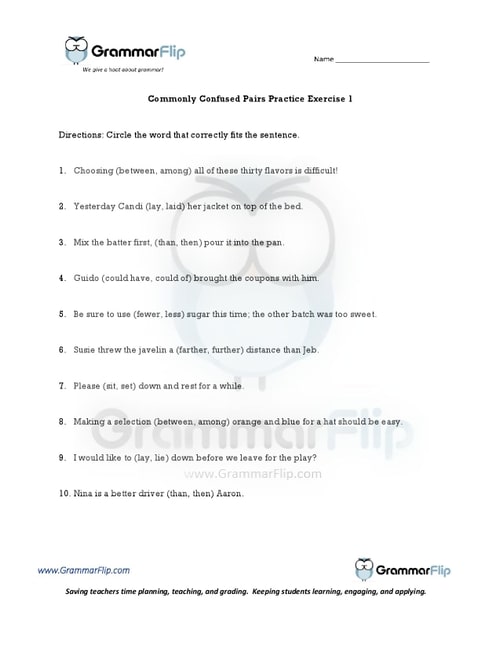What are Commonly Confused Pairs?
Some pairs of words may not be exact homophones but are still easily mixed up if they have similar pronunciations, spellings, and/or meanings.
Examples of Commonly Confused Pairs
Some examples of commonly confused pairs would be the following:
Between / Among
Between: Used in comparison of two items.
– Have you decided between the brownie sundae and the banana split?
Among: Used in comparison of three or more items.
– There must be enough change among the three of us to get soda from the vending machine.
Lie / Lay
Lie: To recline or rest in a flat position. It does not take a direct object.
– I need to lie down for a while.
Lay: To place something down. It requires a direct object.
– Please lay the book on the table.
Compliment / Complement
Compliment: A polite expression of praise or admiration.
– She gave me a nice compliment on my dress.
Complement: Something that completes or goes well with something.
– The wine is a perfect complement to the meal.
Principal / Principle
Principal: The head of a school or the main or most important part of something.
– The school principal gave a speech.
Principle: A fundamental truth or proposition serving as the foundation for belief or action.
– Honesty is an important principle in life.
Elicit / Illicit
Elicit: To draw out a response or reaction.
– The teacher tried to elicit answers from the students.
Illicit: Forbidden by law, rules, or custom.
– He was arrested for his involvement in illicit activities.
Farther / Further
Farther: Refers to physical distance.
– We walked farther than we planned.
Further: Refers to a greater degree, extent, or time.
– We need to discuss this further.
Lose / Loose
Lose: To be unable to find or retain something.
– Be careful not to lose your keys.
Loose: Not tight or securely fastened.
– The screws on the chair are loose.
Be sure to learn these commonly confused pairs so that you understand how to correctly apply them in your writing.
Download a Free Worksheet on Commonly Confused Pairs!
Click the image below to download your free worksheet on commonly confused pairs!

Can your students apply commonly confused pairs correctly in their writing?
Explore More GrammarFlip Lessons!
Parts of Speech lessons provide the building blocks of grammar. GrammarFlip covers these topics in detail to ensure a solid foundation is built. First time learners and students seeking to review the parts of speech can both benefit from the instructional videos and slide show reviews.
Parts of the Sentence lessons are critical for understanding how the parts of speech function in language construction. From the basic to the advanced, these lessons will cover a wide range of grammar topics that can be used in any grade level or classroom.
Mechanics and Usage lessons equip students with the necessary skills to communicate clearly to all audiences. With a focus on the application of these concepts in student writing, these lessons tie together both simple constructions of grammar as well as the more complex such that any age or skill level of student will benefit.

